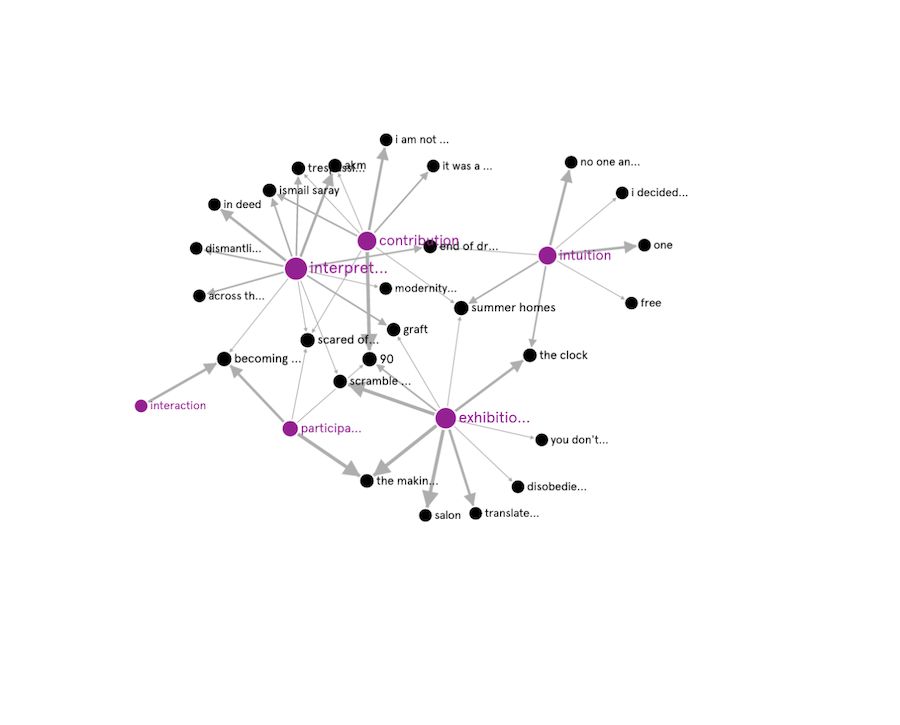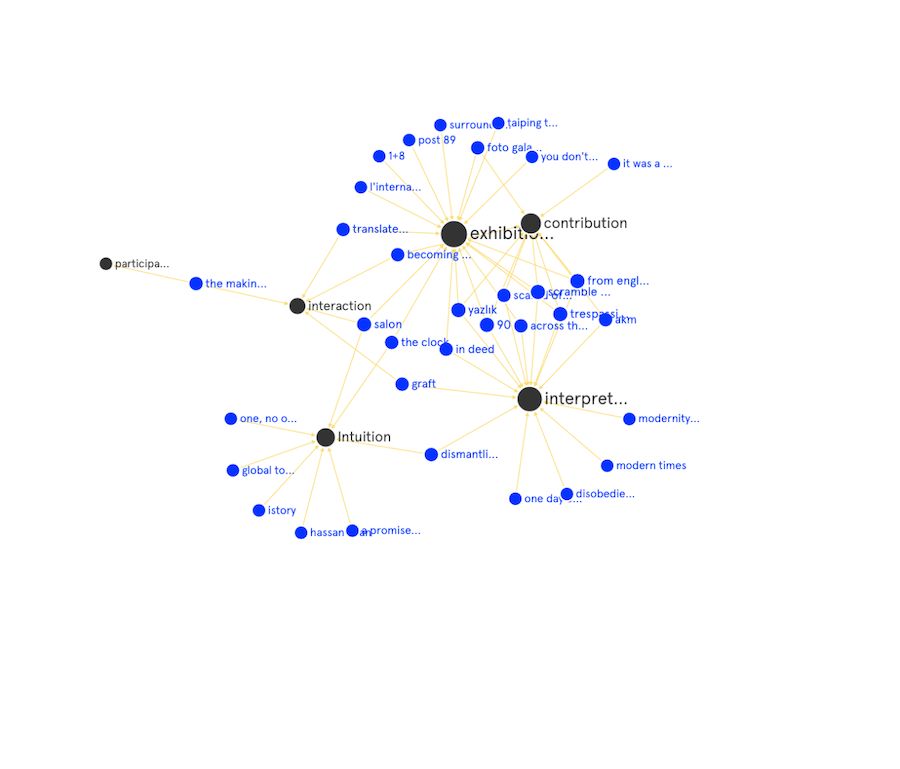In Situ Qualitative
October 21, 2013
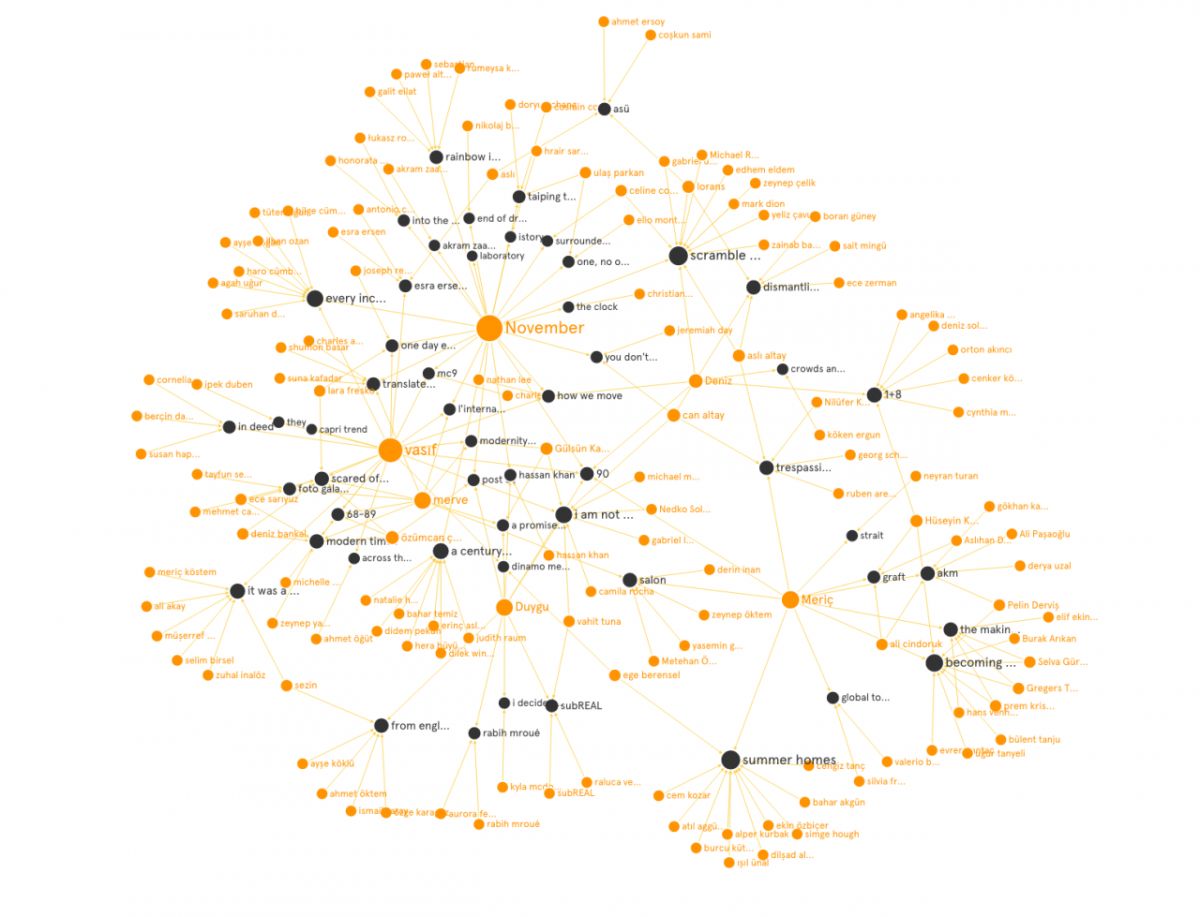
Contributions maps individuals’ contribution in the making of selected programs.
In Situ Qualitative is a program by SALT for The Institute Effect, one of the three main projects in the 2013 Lisbon Architecture Triennale Close, Closer.
Defined as “a living, changing homage to the contemporary institution” The Institute Effect hosts public programs by “12 pioneering institutions engaged in innovative and groundbreaking practice” that can be followed on their blog.
Upon being approached by Dani Admiss, co-curator, The Institute Effect, and Beatrice Galilee, chief curator, Close, Closer, we at SALT took the invitation as an opportunity to probe the individuals’ effect over the institute in three parts.
Maps*:
First we made network maps, which are built on a selection of programs that include all exhibitions, long-term projects and archive visualizations at SALT from April 2011 through October 2013.
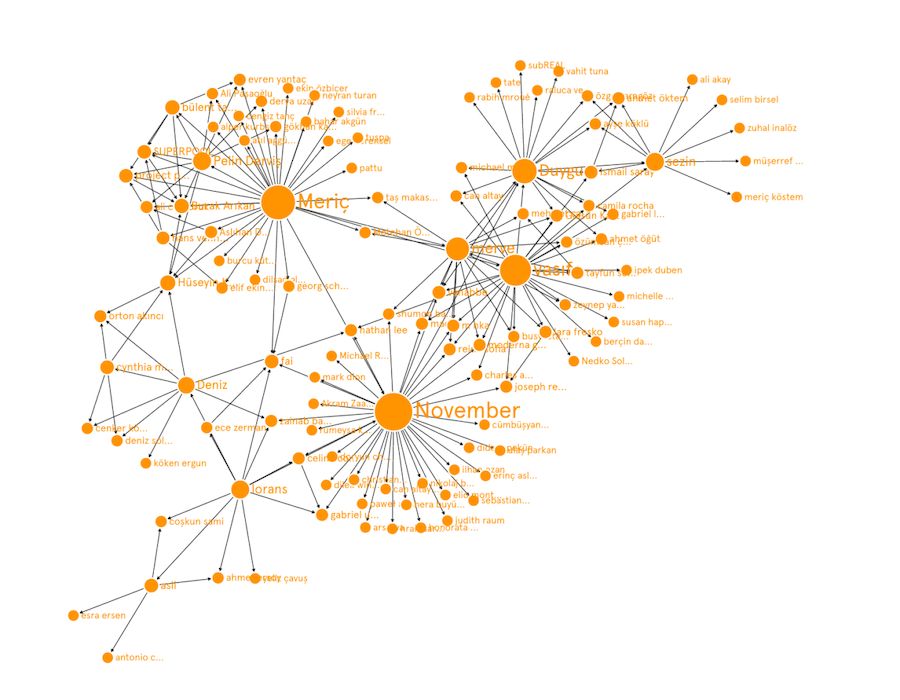
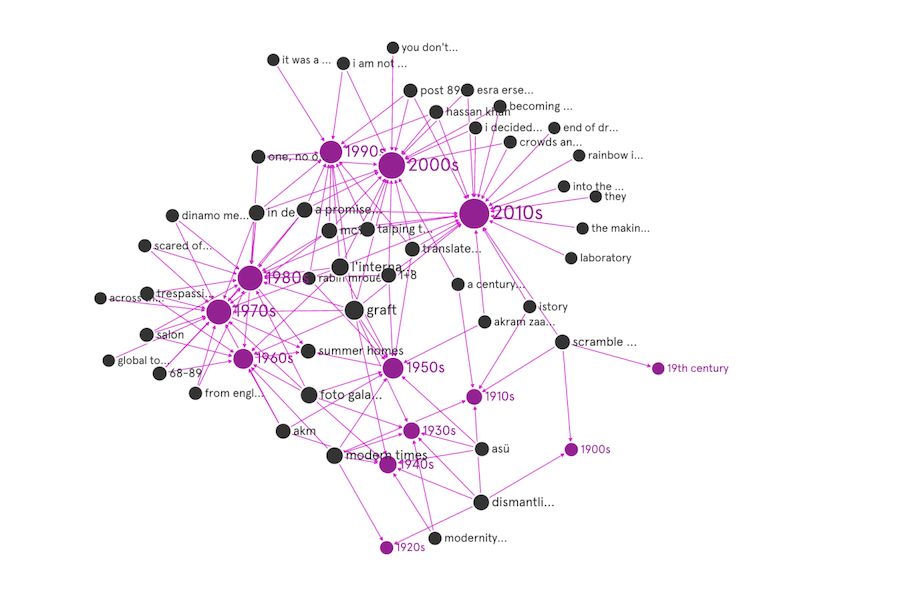
The maps provided so far rely more on technical information than interpretations. They were developed with one on one sessions and through shared editorship of the online maps with the content making members of the SALT Research and Programs.
However, the decision to use network maps in investigating SALT over its programs had stemmed from the idea that these long-term projects seem to be connected in many different ways than they are on the surface. Inter/trans-disciplinarity in quantified definitions is intrinsically avoided in program making at SALT. Yet, as per the maps suggest, the varied interests of individuals do form intersections in forms of projects and/or relations.
To fulfill In Situ Qualitative’s aims we had discussed a number of maps to pin down those that potentially discuss the qualities of the contemporary institution. The first attempts included mapped disciplines and physical definitions. Over face to face sessions and online discussions we listed a number of qualities that we believed to be critical for assessing SALT’s programs and we used them to test on two maps of aim and outcome qualities of selected programs:
Contribution points to any program that welcomes input within the identified frame.
Exhibition making points to any program that probes the practice of exhibiting.
Interaction points to any program that performs only upon user initiation.
Interpretive frame points to any program in which the idea is comprehensively expressed.
Intuition points to any program that is devised without a specific final argument.
Participation points to any program that is open to multiple unanticipated input and discussion throughout its life cycle.
These qualities were voted for each selected program by the members of SALT Research and Programs and those that got 3, 4, 5, 6, and 7 votes from the 7 contributing people were mapped with increased thicknesses showing increased voting frequencies.
The study of these two maps were particularly important in the sense that it enabled a self-analysis that the members of SALT Research and Programs interpret qualities in considerably different directions.
Video:
The video is a collection of experience-based interviews on SALT among the members of SALT Research and Programs, content collaborators and users. It features unedited two minute responses to questions concerning the stated qualities at SALT.
Talks:
The public programs SALT organizes at MUDE for The Institute Effect are two talks with participants from the cultural scene in Portugal, on two main themes that are rendered effective in SALT’s practices.
Superimposition 22 October 2013, 15.00
with André Guedes (artist), João Mourão (curator, Kunsthalle Lissabon) Luís Silva (curator, Kunsthalle Lissabon) and Vasıf Kortun (SALT), Meriç Öner (SALT)
Format 23 October 2013, 15.00
with Filipa Valladares (independent curator / critic), José Capela (architect / teacher / artistic director at Mala Voadora), Luis Santiago Baptista (architect / teacher / curator / editor), Pedro Barateiro (artist) and Vasıf Kortun (SALT), Meriç Öner (SALT)
*All maps are produced collectively with the related members of SALT Research and Programs using Graph Commons, a collaborative network mapping platform developed by Burak Arıkan and Cenk Dölek.
Defined as “a living, changing homage to the contemporary institution” The Institute Effect hosts public programs by “12 pioneering institutions engaged in innovative and groundbreaking practice” that can be followed on their blog.
Upon being approached by Dani Admiss, co-curator, The Institute Effect, and Beatrice Galilee, chief curator, Close, Closer, we at SALT took the invitation as an opportunity to probe the individuals’ effect over the institute in three parts.
Maps*:
First we made network maps, which are built on a selection of programs that include all exhibitions, long-term projects and archive visualizations at SALT from April 2011 through October 2013.

Collaborations maps individuals’ and institutions’ collaborations for selected programs.

Periods maps the focused time-period referenced by selected programs.
The maps provided so far rely more on technical information than interpretations. They were developed with one on one sessions and through shared editorship of the online maps with the content making members of the SALT Research and Programs.
However, the decision to use network maps in investigating SALT over its programs had stemmed from the idea that these long-term projects seem to be connected in many different ways than they are on the surface. Inter/trans-disciplinarity in quantified definitions is intrinsically avoided in program making at SALT. Yet, as per the maps suggest, the varied interests of individuals do form intersections in forms of projects and/or relations.
To fulfill In Situ Qualitative’s aims we had discussed a number of maps to pin down those that potentially discuss the qualities of the contemporary institution. The first attempts included mapped disciplines and physical definitions. Over face to face sessions and online discussions we listed a number of qualities that we believed to be critical for assessing SALT’s programs and we used them to test on two maps of aim and outcome qualities of selected programs:
Contribution points to any program that welcomes input within the identified frame.
Exhibition making points to any program that probes the practice of exhibiting.
Interaction points to any program that performs only upon user initiation.
Interpretive frame points to any program in which the idea is comprehensively expressed.
Intuition points to any program that is devised without a specific final argument.
Participation points to any program that is open to multiple unanticipated input and discussion throughout its life cycle.
These qualities were voted for each selected program by the members of SALT Research and Programs and those that got 3, 4, 5, 6, and 7 votes from the 7 contributing people were mapped with increased thicknesses showing increased voting frequencies.
The study of these two maps were particularly important in the sense that it enabled a self-analysis that the members of SALT Research and Programs interpret qualities in considerably different directions.
Video:
The video is a collection of experience-based interviews on SALT among the members of SALT Research and Programs, content collaborators and users. It features unedited two minute responses to questions concerning the stated qualities at SALT.
Talks:
The public programs SALT organizes at MUDE for The Institute Effect are two talks with participants from the cultural scene in Portugal, on two main themes that are rendered effective in SALT’s practices.
Superimposition 22 October 2013, 15.00
with André Guedes (artist), João Mourão (curator, Kunsthalle Lissabon) Luís Silva (curator, Kunsthalle Lissabon) and Vasıf Kortun (SALT), Meriç Öner (SALT)
Format 23 October 2013, 15.00
with Filipa Valladares (independent curator / critic), José Capela (architect / teacher / artistic director at Mala Voadora), Luis Santiago Baptista (architect / teacher / curator / editor), Pedro Barateiro (artist) and Vasıf Kortun (SALT), Meriç Öner (SALT)
*All maps are produced collectively with the related members of SALT Research and Programs using Graph Commons, a collaborative network mapping platform developed by Burak Arıkan and Cenk Dölek.
